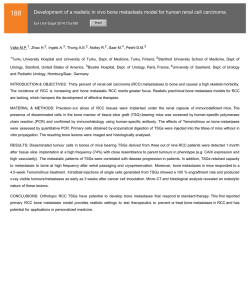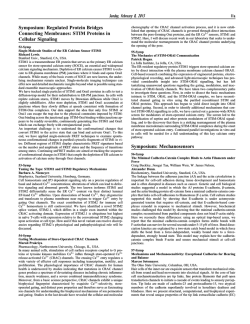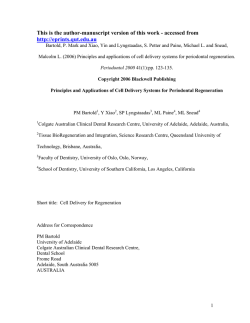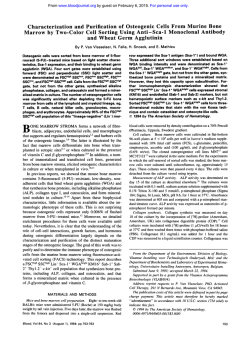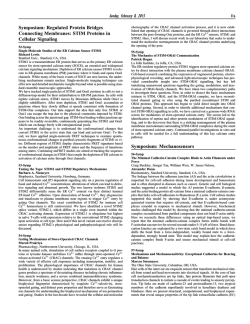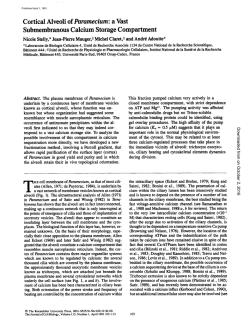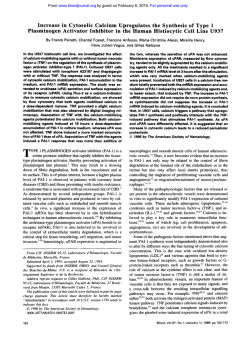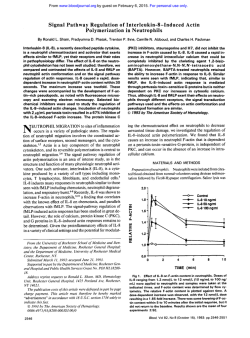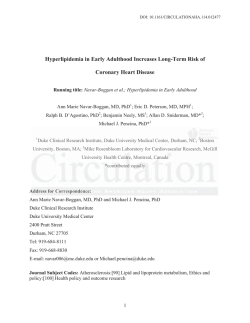
long term effect of thiazides on bone mass in women with - SciELO
www.renal.org.ar nefrología, diálisis y trasplante, volumen 33 - nº 4 - 2013 ARTÍCULO ORIGINAL LONG TERM EFFECT OF THIAZIDES ON BONE MASS IN WOMEN WITH HYPERCALCIURIC NEPHROLITHIASIS EFECTO A LARGO PLAZO DE TIAZIDAS SOBRE LA MASA ÓSEA EN MUJERES CON HIPERCALCIURIA NEFROLITIASIS Francisco R Spivacow, Armando L Negri, Elisa E del Valle Instituto de Investigaciones Metabólicas. Universidad del Salvador. Buenos Aires. Argentina Nefrología, Diálisis y Trasplante 2013; 33 (4) Pag. 180 - 187 ABSTRACT Background: Decreased bone mineral density and increased prevalence of bone fractures have been found in patients with idiopathic hypercalciuria. It is not yet clear if thiazide treatment prevent these events. Methods: We retrospectively evaluated bone mass and biochemical markers of bone turnover in response to thiazide therapy in 52 consecutive female patients with idiopathic hypercalciuria and nephrolithiasis. Patients were divided in two subgroups according to their menopausal status: 25 were pre-menopausal (Group I) and 27 were postmenopausal (Group II). Results: Osteoporosis was found in 12 patients at baseline, 9 at the lumbar spine and 6 at the femoral neck. Two were pre-menopausal and 10 were postmenopausal. Patients with osteoporosis were analyzed separately (Group III). There was a significant and persistent reduction in urinary calcium with preservation of bone mass in all the groups after a median follow-up of 51 months. Few adverse effects were found using low doses of hydrochlorothiazide / amiloride. Only in the group III we found a statistically significant an increase in BMD at the lumbar spine of 9.5% and an increase in BMD at femoral neck of 4.4% that did not reach statistical significance. Conclusions: We conclude that correction of hypercalciuria during long term treatment with low-dose hydrochlorothiazide//amiloride in women with nephrolithiasis prevents bone loss and in those with osteoporosis can lead to a significant increa se in bone mineral density at the lumbar spine. Few adverse effects were seen during treatment and no interruption of therapy was necessary. KEYWORDS: thiazides; bone mass; hypercalciuria; nephrolithiasis RESUMEN Introducción: Reducción de la densidad mineral ósea y aumento de la prevalencia de fracturas óseas se han encontrado en pacientes con hipercalciuria idiopática. Aún no está claro si el tratamiento con tiazidas prevenir estos eventos. Métodos: Evaluamos retrospectivamente la masa ósea y los marcadores bioquímicos de recambio óseo en respuesta a la terapia con tiazidas en 52 pacientes femeninos consecutivos con hipercalciuria idiopática y nefrolitiasis. Los pacientes fueron divididos en dos subgrupos de acuerdo a su estado de la menopausia : 25 fueron pre-menopáusicas (Grupo I) y 27 eran posmenopáusicas (Grupo II). Resultados: La osteoporosis se encontró en 12 pacientes al inicio del estudio, 9 en la columna lumbar y 6 en el cuello femoral. Dos eran premenopáusicas y 10 eran posmenopáusicas. Los pacientes con osteoporosis se analizaron por separado (Grupo III). Hubo una reducción significativa y persistente en el calcio urinario con la preservación de la masa ósea en todos los grupos después de una mediana de seguimiento de 51 meses. Pocos efectos adversos se encuentran utilizando dosis bajas 180 ISSN 0326-3428 Tiazidas y masa ósea en litiasicos hipercalsúricos - Spivacow F.R. y Col de hidroclorotiazida / amilorida. Sólo en el grupo III encontramos un aumento estadísticamente significativo en la DMO de la columna lumbar del 9,5% y un aumento de la densidad mineral ósea en el cuello femoral de 4,4% que no alcanzó significación estadística. Conclusión: Llegamos a la conclusión de que la corrección de la hipercalciuria durante el tratamiento a largo plazo con dosis bajas de hidroclorotiazida / / amilorida en mujeres con nefrolitiasis previene la pérdida ósea y en aquellos con osteoporosis puede conducir a un aumento significativo en la densidad mineral ósea en la columna lumbar. Pocos se observaron efectos adversos durante el tratamiento y no hay interrupción de la terapia era necesario. and bone remodeling markers when used as the only treatment in women with idiopathic hypercalciuria and nephrolithiasis. MATERIALS AND METHODS We retrospectively evaluated bone mass and biochemical markers of bone turnover in response to thiazide therapy, in 52 consecutive female patients with idiopathic hypercalciuria and nephrolithiasis. Study subjects were recruited between 2003 and 2010 among patients seen at our outpatient’s lithiasis clinic. Patients included in this report satisfied the following criteria: (a) they had idiopathic hypercalciuria (urinary calcium excretion > 220 mg/24 h or > 4 mg/Kg body weight on a normal calcium diet with normal serum calcium) b)they have passed or had a positive detection study for urinary calculi (either a plain abdominal radiograph or renal sonography); (c) they had normal renal function determined by creatinine clearance (c) none had a diagnosis of primary hyperparathyroidism, intestinal fat malabsorption, distal renal tubular acidosis, systemic malignancy or liver disease (cirrhosis or hepatitis); (d) they have not been treated with calcium salts, bisphosphonates, teriparatide, SERM, strontium ranelate, fluoride, or have been on long-term glucocorticoid therapy at least one year before being included in the study. Bone mass was assessed by Dual energy X-ray absorptiometry (DXA) using Lunar Prodigy densitometer (Lunar Corporation, General Electric, Madison. WI, USA) measured at the lumbar spine (LS) and femoral neck ((FN). Fasting morning venous blood samples were obtained before breakfast and analyzed for creatinine, calcium, phosphorus, 25 OH D, total alkaline phosphatase (ALP), bone-specific alkaline phosphatase (BAP), glucose, total cholesterol, uric acid, serum potassium and serum β crosslaps (CTX). 24-hour urine samples were obtained from each patient for determination of calcium, sodium and creatinine. Bone densitometry was performed at baseline and during follow-up under thiazide treatment. Laboratory determinations were obtained as closely as possible to the bone mass determinations. All patients received a diuretic combination (amiloride + hydrochlorothiazide) as treatment for their hypercalciuria. Dose was adjusted according PALABRAS CLAVE: Las tiazidas; masa ósea; hipercalciuria; nefrolitiasis INTRODUCTION Reduced bone mineral density (BMD) is a common finding in calcium stone forming patients (SF) principally men and in genetic hypercalciuric rats (1–7). The pathogenesis of bone mass reduction in hypercalciuria involves the interplay of many factors, some linked to the negative calcium balance produced by dietary calcium restriction recommended to patients in the past (1). Some authors have found increased in bone resorptive activity (2). Jaeger et al (12) found a negative correlation between pyridinoline in 24 hr-urine and tibial shaft BMD. Other authors found impaired osteoblast activity without changes in the resorptive activity (10,11) Different treatments have been used to control of hypercalciuria, irrespective of the mechanisms that causes low bone mass, Some of them include bisphosphonates (7,13), even though most consider the thiazide diuretics as the drugs of choice (1416). A few open-label prospective studies have suggested that thiazide diuretics may have beneficial effects on bone (15). Two randomized studies (17,19) showed modest gains in bone mass. In the same way, in a prospective randomized placebo-controlled study a small effect in preventing bone loss at the hip and spine was noted after 3 years (19). The aim of the present study was to evaluate the long-term effects of thiazides on bone mass 181 www.renal.org.ar nefrología, diálisis y trasplante, volumen 33 - nº 4 - 2013 to the reduction in urinary calcium. In addition, all patients received calcium and vitamin D in the case of deficit. All study procedures were approved by the institutional review board of the Metabolic Research Institute (CODEI) and each study participant gave his written informed consent for the use of their clinical records for scientific purposes. 226 pg/ml. 25 OH D Radioinmunoanálisis, normal value: 20-40 ng/ml. Statistical analyses Changes in bone densitometry and biochemical parameters between the beginning of treatment and last follow-up were assessed by two-sided paired T-test. A p < 0.05 was considered significant. RESULTS Result are expressed in mean The whole group had a mean ± standard desviations (SD) age of 49.3 ± 12.0 years. Their weight was 59.2 ± 8.9 Kg and their BMI was 23.6 ± 2.9 Kg/height2. Patients were divided in two subgroups according to their menopausal status: 25 were pre-menopausal (mean age 39.7 ± 8.8 years, weight 58.3 ± 9.9 Kg and BMI 22.9 ± 2.9 Kg/height2) (Group I) and 27 were postmenopausal (mean age 58.1 ± 6.5 years, weight 60.0 ± 8.0 Kg and BMI 24.2 ± 2.8 Kg/ height2) (Group II). Osteoporosis was found in 12 patients at baseline, 9 at the lumbar spine and 6 at the femoral neck. Two were pre-menopausal and 10 were postmenopausal. These patients were analyzed separately (Group III). Patients were treated for median of 51 months. Urinary calcium, sodium and UCa/ KgBW index at baseline and at the end of follow up for the whole group are shown in the Table I. Laboratory methods Serum and urine calcium, sodium and potassium were measured by ion-selective electrode (ISE) method using a Synchron CX3 automated analyzer (Beckman, Beckman Instruments inc. Brea, California. USA). Normal values for total serum calcium: 8.8-10.5 mg/dl, urinary calcium: < 220 mg/ 24 h, serum sodium: 136 – 145 mEq/L, serum potassium: 3.9 – 4.5 mEq/L. Creatinine (Jaffe kinetic method) and phosphate (UV) were measured using CCX Spectrum automated analyzer (Abbott Labs. USA). Normal values for serum creatinine: 0.6 – 1.1 mg/dl, Normal values for phosphate: 2.7 - 4.5 mg/dl. Uric acid was analyzed by the uricase method. Normal value: 2.5 – 5.5 mg/dl. Total alkaline phosphatase and its bone isoenzime (Kinetic method RR: 90-280 UI/l and 20-48% respectively). Serum β crosslaps (CTX): electrochemiluminescence, RR: 556 ± Table I: Urinary calcium, UCa/KgBW and urinary sodium at baseline and at the end of follow-up in the whole group. Parameters Baseline End follow-up % change p UCa mg/24 h 298 ± 71 182 ± 58 - 38 < 0.001 UCa mg/ 5.0 ± 1.1 3.1 ± 1.1 - 38 < 0.001 KgBW UNa mEq/24 h 152 ± 74 141 ± 55 - 7.19 NS high values which led to increases or reductions in diuretic doses. In no case was it necessary to stop thiazide treatment because of lack of response. On the other hand, in some cases, an adjustment was made in the dietary salt, calcium and animal We observed a 38% decrease in urinary calcium and UCa/KgBW index between baseline and end of follow-up, without significant changes in urinary sodium. During follow-up, urinary calcium excretion in some patients ranged from low to 182 Tiazidas y masa ósea en litiasicos hipercalsúricos - Spivacow F.R. y Col ISSN 0326-3428 protein. The average dose of hydrochlorothiazide and amiloride to achieve urinary calcium normalization was of 25.8 ± 11.6 and 3.75 ± 2.5 mg respectively. Table II, shows the changes in the three groups. We did not observe differences in the parameters measured, among the three groups of patient at the beginning and the end of follow-up. The doses of thiazide used in subgroup I was 26.5 ± 12 mg/d, in subgroup II the doses was 25.5 ± 10 mg/d, while in those with osteoporosis the doses was 28.1 ± 14 mg/d, without statistically significant between the three. Finally, we note that premenopausal and postmenopausal women, and Table II: Changes in urinary calcium, UCa/KgBW and urinary sodium between baseline and end follow-up in the three groups Group I Group II Group III Parameters Baseline End follow-up Baseline End follow-up Baseline End follow-up UCa mg/24 Hr 303 ± 65 201 ± 83* 293 ± 77 184 ± 75* 300 ± 63 193 ± 94 UCa mg/KgBW 5.2 ± 1.3 3.5 ± 1.6* 4.9 ± 1.0 3.2 ± 1.4* 5.1 ± 1.1 3.3 ± 1.8 UNa meq/24 Hr 159 ± 71 144 ± 55 146 ± 79 143 ± 62 124 ± 54 135 ± 67 * <0.001 vs. baseline and femoral neck did not change significantly. Only in the group III we found an increase in BMD at the lumbar spine of 9.5% that was statistically significant. Also, in the same group, we found a 4.4% increase in BMD femoral neck but no reaching statistical significance, probably be- those who had osteoporosis had similar values in the calciuria at baseline and also had a similar response to treatment, receiving similar doses of thiazides in all cases. Bone mass initial and final values are shown in Table III. In the total group BMD at the lumbar Table III: Changes in BMD in the three groups between baseline and the end of follow-up Group I Group II End Follow-up Baseline End Follow-up Baseline LS BMD 1.102 ± 0.136 1.075 ± 0.281 FN BMD 0.880 ± 0.126 0.893 ± 0.122 Group III Baseline End Follow-up 0.930 ± 0.187 0.969 ± 0.166 0.796 ± 0.872 ± 0.099* 0.744 ± 0.105 0.758 ± 0.102 0.120 0.676 ± 0.706 ± 0.109* 0.084 LS BMD: Lumbar spine bone mineral density; FN BMD: Femoral neck bone mineral density * p < 0.05 vs. baseline cause of the small number of patients. No were no changes in creatinine, calcium and serum phosphorus levels in the three subgroups analyzed. The bone remodeling parameters and 25 OH D levels are shown in Table IV. We only observed an increase of ALP in the subgroup of postmenopausal women (p < 0.05) and mainly in the group with osteoporosis in which the increase in the ALP was of 28%, that was statistical significance (p <0.01). The rest of mineral parameters 183 www.renal.org.ar nefrología, diálisis y trasplante, volumen 33 - nº 4 - 2013 no showed significant changes. With respect to 25 OH D, the level was kept in acceptable values, during the whole follow-up, linked to the corrections of the same one with supplements. The doses of hydrochlorothiazide used in the different subgroups were 26.5 ± 12 mg (Group I), 25.5 ± 11 mg (Group II) and 28.2 ± 14 mg (Group III). Table IV: Bone remodeling markers and 25 OH D in the three groups of patients between baseline and end of follow-up Group I Parameters Group II Group III Baseline End follow-up Baseline End follow-up Baseline ALP (U/L) 154.1 ± 73 BAP (%) 31.3 ± 20.6 CTX (pg/ml) 358 ± 174 25OH D (ng/ 28.1 ± 13 ml) 175.2 ± 85 37.5 ± 5.4 345.8 ± 195 27.9 ± 8 138.7 ± 61 44.3 ± 12.4 467 ± 282 27.5 ± 13 *p< 0.05 vs. baseline; **p < 0.01 vs. baseline The serum levels of glucose, cholesterol, uric acid, sodium and potassium were analyzed in these patients as long term administration of thiazides can cause changes. Values at baseline and the end of study are shown in Table V . We only found slight significant decreases in serum sodium and potassium the end of study (p < 0.01 and p < 0.05 respectively). Of all patients, mild hypokalemia (3 - 3.5 mEq/l) 176.9 ± 35* 41.1 ± 11.2 346.7 ± 159 31.5 ± 7 145.8 ± 65 42.7 ± 14.6 455 ± 270 27.3 ± 10 End follow-up 186.9 ± 51** 40.5 ± 10.7 329 ± 174 32.1 ± 5 was observed in 5 patients (9.6%), hyperglycemia in 1 (2%), hypotension in 4 (7.7%), palpitations, cramps and headaches in 2 patients (3.8%) in each case. In no patients was it necessary to stop the medication due to adverse effects. A clear decline in kidney stones recurrence was found although it was not an aim of this study (data not shown) Table V: Changes in blood glucose, cholesterol, acid uric, sodium and potassium at baseline and end of followup in the whole group Parameters Baseline End follow-up p 88.6 ± 9.0 90.4 ± 19 NS 201.2 ± 29.3 207.5 ± 31.1 NS Uric Acid mg/dl 4.0 ± 0.8 4.1 ± 0.8 NS Sodium mEq/L 139.6 ± 5.5 137.1 ± 2.1 < 0.01 4.6 ± 0.4 4.0 ± 0.3 < 0.05 Glucose mg/dl Cholesterol mg/dl Potassium mEq/L 184 ISSN 0326-3428 Tiazidas y masa ósea en litiasicos hipercalsúricos - Spivacow F.R. y Col DISCUSSION Our results show a significant reduction in hypercalciuria, preservation of bone mass with few adverse effects using low doses of hydrochlorothiazide / amiloride for a long period of time. The reason to use amiloride associated with a thiazide diuretic is based on the attempt to reduce the fall of the serum potassium and enhance the hypocalciuric effect. Thiazide diuretics, which inhibit sodium-chloride cotransporter (NCC) in the distal convoluted tubule, are considered as the treatment of choice for idiopathic hypercalciuria due to their hypocalciuric effect (20). The mechanism this effect and the effect of thiazides on calcium transporters in the distal convoluted tubule are still controversial. Recently Hye Ryoun et al. have suggested that TRPV5 is a critical determinant of the hypocalciuric effect of chronic HCTZ treatment (21). Amiloride is a small molecule diuretic, known to interact with the epithelial sodium channel and acid-sensing ion channel proteins, as well as sodium/hydrogen antiporters and sodium/calcium exchangers (22). With simultaneous administration of amiloride, the hypocalciuric effect of HCTZ is increased and potassium and magnesium depletion is prevented (23). The effect of idiopathic hypercalciuria on bone has been widely evaluated in patients with calcium nephrolithiasis. Many authors have reported that the increase in urinary calcium excretion is associated with decreased bone mass and increased bone turnover in patients with kidney stones (4–6). Therefore, the reduction of the calciuria could avoid the loss of bone mass, suggested by some authors (24, 25). Using low doses of thiazides we observed a fall of 38% in urinary calcium, reaching normal ranges. Values lower than 47% were achieved after one year, by Rico et al. in 24 hypercalciuric patients (14), and as 45.9% in 14 male patients with idiopathic hypercalciuria (5 with a history of renal colic) reported by LegrouxGerot et al.(15) with a average doses of thiazides of 44.7 ± 9.4 mg/day, for a period of 18 months, but in both cases using doses of thiazides almost twice our. The hypocalciuric effect of long term thiazide treatment (18-24 months) may have a limited action with possible return of calciuria, in some cases to levels prior to treatment, especially in the absortive hypercalciuria (26). This seems due that the increase of calcemia that would stimulate the thyroid C cells with calcitonine production that increase the urinary excretion of calcium (27). In our patients when urinary calcium was not controlled initially, salt and animal protein was restricted and if no response was found, thiazide dose was increased. We found no differences in urinary calcium at baseline nor in their response to thiazides when we divided patients in pre-and post-menopausal or in those with or without osteoporosis. Therefore, all had the same initial levels and the responses to thiazides were similar. In this study we found that in 52 patients with nephrolithiasis and hypercalciuria treated with thiazide/ amiloride there was a small not statistically significant increase in BMD at both lumbar spine and femoral neck. Despite this, in the group III with OP (12 patients) there was a statistically significant increase in lumbar spine BMD after a median follow-up of 75.9 months; at the femoral neck BMD increased of 4.4% that was not statistically significant. Rico et al. (14) found a 5% increase in wholebody bone mass, after 1 year of treatment with thiazides. Pak et al. (28) evaluated the effects of a low calcium diet and thiazide diuretic therapy for 3 years, in 28 patients (18 men and 10 women) with absorptive hypercalciuria and found an increase of 5.7% in lumbar spine T-score, similar to the 5.4% we found b at the lumbar spine but without differences in femoral neck BMD. The changes found in BMD in both lumbar spine and femoral neck in the OP group, can be explained by a closer follow-up with more stringent control in diet and thiazides doses, because these patients were not given other osteoactive medications. On the other hand the initial BMD values were lower than the other two groups, therefore giving place to greater improvements. We found no significant changes in the different markers of mineral metabolism and bone remodeling, except for a moderate increase in ALP in both, the postmenopausal group and the group with OP. Aubin et al (29) using the cellular line of MG-63 to study the action of thiazides on osteoblasts, found that while HCTZ had no affect on cell growth and DNA synthesis but increased alkaline phosphatase activity slightly, which may reflect increased differentiation of these cells. La Croix et al. found in patients on thiazide diu185 www.renal.org.ar nefrología, diálisis y trasplante, volumen 33 - nº 4 - 2013 retic a decrease in markers for bone resorption (N-telopeptide) and bone formation (osteocalcin and BAP) but no significant changes in ionized calcium and PTH (19,30). Reductions in tartrateresistant acid phosphatase with thiazide indicates that high rate of bone remodeling in idiopathic hypercalciuria is decreased by these drugs (14). The mechanism of action remains unclear but is probably due that some effects on osteoclast (31) or 1.25OH D3 (32). In addition, although thiazides may act directly on bone resorption (19, 30), the reduction of renal calcium excretion remains the most important contributing factor to maintenance or slight improvement in bone mineral density detected in thiazide-treated subjects (19–32), and causing a sustained positive calcium balance in time as we have suggested in earlier work (1). Because we did not alter the calcium intake of our patients, we suspect that the increase in bone mineral density resulted from hydrochlorothiazide + amiloride administration. The treatment was well tolerated during followup. None of the thiazide patients stopped their medication before the end of 71.3 months of the median study period. The side effect most frequent was hypokalemia, which occurred in only the 9.6% patients and required potassium supplementation in some of them. The other adverse effects were not relevant. In summary, we show that correction of hypercalciuria during long term treatment with low-dose hydrochlorothiazide//amiloride in women with nephrolithiasis prevents bone loss and in those with osteoporosis can lead to a significant increase in bone mineral density at the lumbar spine. Few adverse effects were seen during treatment and no interruption of therapy was necessary. Clin Nephrol 1998; 50: 94–100. 5. Bataille P. Achard JM. Fournier A et al. Diet. vitamin D and vertebral mineral density in hypercalciuric calcium stone formers. Kidney Int 1991; 39: 1193–1205. 6. Borghi L. Meschi T. Guerra A et al. Vertebral mineral content in diet-dependent and diet-independent hypercalciuria. J Urol 1991; 146: 1334–1338. 7. Bushinsky DA. Neumann KJ. Asplin J. Krieger NS. Alendronate decreases urine calcium and supersaturation in genetic hypercalciuric rats. Kidney Int 1999: 55: 234-243. 8. Herings RM, Stricker BH, de Boer A, Bakker A, Sturmans F, Stergachis A. Current use of thiazide diuretics and prevention of femur fractures. J Clin Epidemiol 1996; 49:115-119. 9. Lauderdale DS. Thisted RA. Wen M. Favus MJ. Bone mineral density and fracture among prevalent kidney stone cases in the Third National Health and Nutrition Examination Survey. J Bone Miner Res 2001; 16: 1893–1898. 10. Steiniche T. Christensen MS. Melsen F. A histomorphometry determination of iliac bone remodeling in patients with recurrent bone formation an idiopathic hypercalciuria. APMIS1989; 97:309-316. 11. Malluche HH. Tschoepe HH. Ritz WE. Massry SG: Abnormal bone histology in idiopathic hypercalciuria. J.Clin Endocrinol Metab 1980; 50: 654. 12. Jaeger P. Lippuner K. Hug C. Low Bone Mass in Idiopathic Renal Stone formers: Magnitude and Significance. J Bone Miner Res 1994; 9: 1525-32. 13. Heilberg IP. Martini LA. Teixeira SH. Szejnfeld VL. Carvalho AB. Lobao R. Draibe SA. Effect of etidronate treatment on bone mass of male neprholithiasis patients with idiopathic hypercalciuria and osteopenia. Neprhon 1998; 79: 430-437. 14. Rico H. Revilla M. Villa LF. Arribas I. Alvarez de Buergo M. A longitudinal study of total and regional bone mineral content and biochemical markers of bone resorption in patients with idiopathic hypercalciuria on thiazide treatment. Miner Electrolyte Metab 1993; 19: 337-342. 15. Legroux-Gerot I. Catanzariti L. Marchandise X. Duquesnoy B. Cortet B. Bone mineral density changes in hipercalciuretic osteoporotic men treated with thiazide diuretics. Joint bone spine 2004; 71: 51-55. 16. Lalande A. Roux S. Denne MA. Stanley ER. Schiavi P. Guez D. De Vernejoul MC. Indapamide. a thiazide-like diuretic. decreases bone resorption in vitro. J Bone Miner Res 2001; 16: 361-370. 17. Transbol I. Christensen MS. Jensen GF. Christiansen C. McNair P. Thiazide for the postponement of postmenopausal bone loss. Metabolism 1982; 31: 383-386. 18. Wasnich RD. Davis JW. HeYF. Petrovich H. Ross PD. REFERENCES 1. Zanchetta JR. Rodriguez G. Negri AL et al. Bone mineral density in patients with hypercalciuric nephrolithiasis. Nephron 1996; 73:557–560. 2. Heilberg IP, Weisinger JR: Bone disease in hypercalciuria. Curr Opin Nephrol Hypertens 2006; 15:394–402. 3. Weisinger JR: New insights into the pathogenesis of idiopathic hypercalciuria: The role of bone. Kidney Int 1996; 49:507-1518. 4. Giannini S. Nobile M. Sartori L et al. Bone density and skeletal metabolism are altered in idiopathic hypercalciuria. 186 Tiazidas y masa ósea en litiasicos hipercalsúricos - Spivacow F.R. y Col ISSN 0326-3428 A randomized double-masked. placebo-controlled trial of chlorthalidone and bone loss in elderly women. Osteoporosis Int 1995; 5: 247-251. 19. La Croix AZ. Ott SM. Ichikawa I. Scholes D. Barlow WE. Low dose hydrochlorothiazide and preservation of bone mineral density in older adults. A randomized double-blind. placebo controlled trial. Ann Intern Med 2000; 133: 516 - 526. 20. Costanzo LS. Weiner IM. On the hypocalciuric action of chlorothiazide. J Clin Invest 1974; 54: 628-3. 21. Hye Ryoun Jang. Sejoong Kim. Nam Ju Heo. Jeong Hwan Lee. Hyo Sang Kim. Soren Nielsen et al. Effects of Thiazide on the Expression of TRPV5. Calbindin-D28K. and Sodium Transporters in Hypercalciuric Rats. J Korean Med Sci 2009; 24 (Suppl 1): S161-9. 22. Qadri YJ, Song Y, Fuller CM, Benos DJ. Amiloride docking to acid-sensing ion channel-1. J Biol Chem. 2010; 26; 285: 9627-35. 23. Bataille P, Fardellone P, Ghazali A, Cayrolle G, Hottelart C, Achard JM et al. Pathophysiology and treatment of idiopathic hypercalciuria. Current opinion in Rheumatology. 1988: 10: 373-88. 24. Peris P, Guañabens N, Monegal A, Suris X, Alvarez L, Martinez de Osaba MJ, Hernandez MV, Muñoz-Gomez J. Aetiology and presenting symptoms in male osteoporosis. Br J Rheumatol. 1995; 34: 936-41. 25. Preminger GM, Pak CYC. Eventual attenuation of hy- percalciuric response to hydrochlorothiazide in absorptive hypercalciuria. J Urol 1987; 137: 1104-09. 26. Arrabal M, Lancina A. Tratamiento médico de la enfermedad litiásica. In Arrabal, M, Lancina, A, García, M. Criterios clínicos y tratamiento actual de la litiasis urinaria. ENE Ediciones SA, Madrid. 1990; pag. 91-111. 27. Perry HM 3d. Fallon MD. Bergfeld M. Teitelbaum SL. Avioli LV. Osteoporosis in young men: a syndrome of hypercalciuria and accelerated bone turnover. Arch Intern Med. 1982;142:1295-8. 28. Pak CYC. Heller HJ. Perale MS. Odvina CV. Poindexter JR. Peterson RD. Prevention of stone formation and bone loss in absorptive hypercalciuria by combined dietary and pharmacological interventions. J Urol 2003; 169: 465-9. 29. Aubin R, Menard P, Lajeunesse D. Selective effect of thiazides on the human osteoblast-like cell line MG-63. Kidney Int 1996; 50:1476-1482. 30.Reid IA. Ames RW. Orr-Walker BJ. Clearwater JM. Horne AM. Evans MC. et al. Hydrochlorothiazide reduces loss of cortical bone in normal postmenopausal women: a randomized controlled trial. Am J Med 2000; 109: 362-9. 31. Hall TJ. Schaueblin M. Hydrochlorothiazide inhibits osteoclastic bone resorption in vitro. Calcif Tissue Int 1994; 55: 266-8. 32. Adams JS. Song CF. Kantorovich V. Rapid recovery of bone mass in hypercalciuric osteoporotic men treated with hydrochlorothiazide. Ann Int Med 1999; 130: 658-60. Recibido en su forma original: 06 de noviembre de 2013 En su forma corregida: 02 de diciembre de 2013 Aceptación final: 13 de diciembre de 2013 Dr. Francisco R. Spivacow Instituto de Investigaciones Metabólicas - Buenos Aires, Argentina e-mail: [email protected] 187
© Copyright 2025
